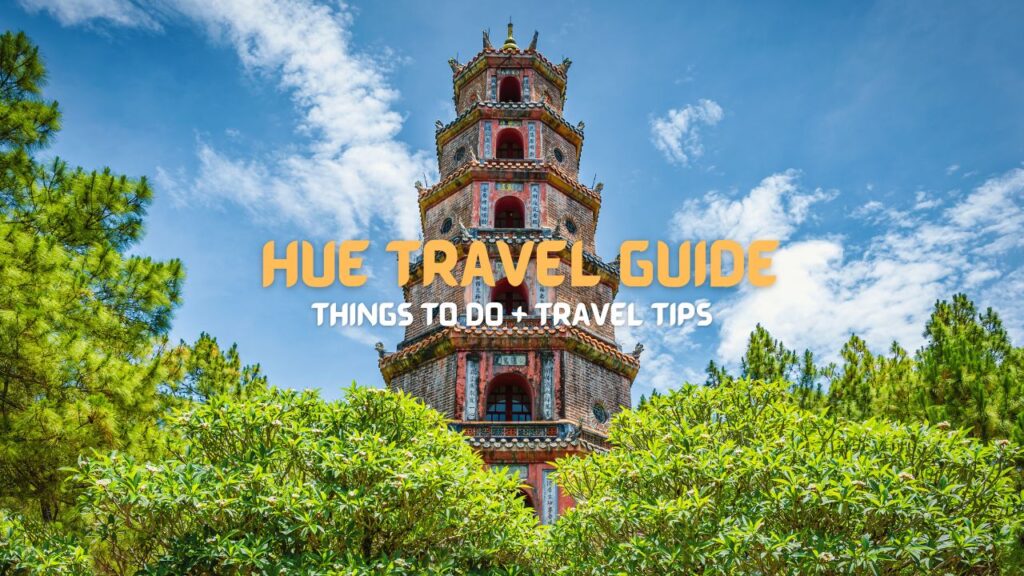Hue Travel Guide: Things to Do + Travel Tips
14 min read
Hue Travel Essentials: Navigating the Imperial City with Ease
Travelers who are interested in exploring the cultural heritage of Vietnam will find Hue an immensely rewarding destination. Hue, the former imperial capital, is renowned for its regal history and offers a glimpse into the grandeur of Vietnam’s dynastic past. The city is located on the banks of the picturesque Perfume River and is famous for its majestic monuments, ancient tombs, and serene pagodas, all of which narrate the stories of the Nguyen Dynasty that ruled from the 19th to the mid-20th century.
A trip to Hue is incomplete without exploring the Imperial City, a UNESCO World Heritage site. Visitors can wander through palaces and shrines steeped in history, admiring the captivating architecture and artistry. This sprawling complex serves as a testament to the city’s historical significance and cultural wealth. Apart from the Imperial City, Hue’s cuisine is also a standout, offering travelers the chance to indulge in unique local dishes that reflect the city’s imperial heritage.
Aside from the splendor of historic sites, Hue’s natural surroundings provide a tranquil escape. The Perfume River gracefully meanders through the city, offering boat rides that afford picturesque views, particularly as the sun sets behind the distant mountains. For those with a spirit for adventure, a day trip to Bach Ma National Park presents the opportunity to behold lush landscapes and spectacular biodiversity. Hue encapsulates a rich tapestry of history, culture, and natural beauty, waiting to be discovered by those who venture to this storied city.
Planning Your Trip to Hue
When planning a trip to Hue, it is crucial to consider the optimal time to visit and understand the transportation options both to get there and for exploring the city. Knowledge of local weather patterns and transport infrastructure will greatly enhance the travel experience.
Best Time to Visit
The best time to visit Hue is from February to April, when the weather is pleasant with moderate temperatures and the rainfall is lower. This period is ideal for exploring the historical sites and enjoying the natural beauty without the hindrance of heavy rains, which are common from May to August.
Getting There and Around
Arriving at Hue is facilitated via the Phu Bai International Airport, which is approximately 15 kilometers from the city center. Those coming from Hanoi or Ho Chi Minh City have the option of a direct flight to Hue. Travelers can also reach Hue by train from these cities, offering scenic views of the Vietnamese countryside.
Upon arrival, getting around the city can be done by various means. Taxis and drivers are readily available for hire. For those comfortable with navigating on their own, arranging a rental motorbike is a common and flexible option. Those who prefer not to drive can opt for a private car with a driver for a more relaxed sightseeing experience.
Travelers coming from the charming city of Hoi An or Da Nang, which is known for its serene beaches, can take a bus or train, or hire a private car to reach Hue. The drive from Da Nang to Hue along the coast is noteworthy for its breathtaking views.
For a detailed itinerary and further travel guide information, referencing reliable travel guides and resources is recommended to ensure a well-planned trip.

Accommodations and Dining
Choosing the right accommodation and dining options can greatly enhance a traveler’s experience in Hue. Comfortable lodging offers a peaceful retreat after a day of exploration, while the local cuisine is a foray into the region’s rich cultural heritage.
Where to Stay
Hue offers a diverse range of hotels catering to various preferences, ensuring travelers find the perfect place to rest. For those seeking proximity to the vibrant city center, Hue Hotels & Resorts provides a memorable stay with their “We Got Hue” Promo which includes room accommodation for two persons, offering both convenience and quality service. For a more tranquil setting suitable for families, consider neighborhoods such as Huong Long, where serenity is a given.
- Vinh Ninh: Ideal for first-time visitors.
- Vy Da: Suitable for couples and budget travelers.
- Thuan Thanh: Offers a cooler, more local experience.
- Phu Hoi: Known for great nightlife and food options.
Top Restaurants and Cuisine
Dining in Hue is an adventure in itself, with restaurants offering a blend of traditional and contemporary flavors. Food enthusiasts must try the famous bun bo Hue, a spicy beef noodle soup that has become synonymous with the city. For a taste of authentic Hue cuisine, Com Hen, a rice dish with mussels, delivers complex flavors that are both unique and satisfying.
- Banh Beo: Delicate steamed rice cakes topped with shrimp and crisp pork skin.
- Banh Ram It: Sticky rice dumplings served on fried rice paper.
- Nem Lui: Lemongrass skewers of grilled pork, a perfect savory treat.
Travelers can relish these dishes and many more at renowned restaurants dotted around Hue, ensuring an immersive experience of the local cuisine. Whether one is in search of upscale dining or a simple street-side eatery, Hue satisfies every palate with its culinary delights.
Hue’s Cultural Heritage
Hue stands as a testament to Vietnam’s grand history, showcasing an illustrious past shaped by the Nguyen Dynasty through its majestic Imperial City and the Citadel.
Historical Background
The history of Hue is deeply connected to the Nguyen lords who first established their presence in the region in the 18th century. It was later designated as the capital of unified Vietnam in 1802 under the Nguyen Dynasty. They ruled from Hue, making significant contributions to the country’s cultural fabric, which can still be observed today.

Imperial City and the Citadel
The Imperial City of Hue, surrounded by the mighty Citadel, serves as the epicenter of the nation’s historical and cultural evolution. This architectural marvel, with influences from both Eastern and Western design, was constructed for the exclusive use of the emperor, his family, and his court.

At the heart of the Imperial City lies the Forbidden Purple City, once the reserved home for the Nguyen Emperor and his royal family. The precinct remains, albeit partially damaged during past conflicts, as a living museum representing Vietnam’s imperial architecture and culture. The complex is renowned for its ornate temples, exquisite palaces, and well-maintained gardens, all reflecting the prominence of Hue’s cultural heritage.
Historical Sites and Monuments
Hue’s rich tapestry of history is encapsulated in its array of historical sites and monuments, of which the Royal Tombs and Religious Sites stand out. These landmarks not only reflect the grandeur of past Vietnamese dynasties but also their spiritual depth.



Royal Tombs
Hue is renowned for the Royal Tombs of the Nguyen dynasty emperors, which amalgamate architectural finesse with the natural landscape. Among these, Khai Dinh Tomb represents a fusion of Western and Eastern styles, its interior adorned with intricate glass and ceramic mosaics. Tu Duc Tomb, often referred to as a poem in stone, served as both the Emperor’s retreat and his final resting place. Visitors should also explore Minh Mang Tomb, known for its symmetrical design and serene lakes.
- Khai Dinh Tomb: Lavish designs, intricate mosaics.
- Tu Duc Tomb: Poetic atmosphere, extensive park.
- Minh Mang Tomb: Balanced architecture, tranquil ambiance.
Religious Sites

The spiritual heritage of Hue shines at its many pagodas and temples. Standing since 1601, Thien Mu Pagoda is not only a religious icon but also a symbol of Hue, overlooking the Perfume River. At this seven-story pagoda, stories of its past kings and residents unfold, connecting visitors to Hue’s spiritual history. Temples scattered across Hue also narrate tales of the city’s religious fervor and traditional beliefs.
- Thien Mu Pagoda: Historic seven-story pagoda, iconic landmark.
- Other Temples: Sites of worship, cultural significance.
Visitors to Hue are guided through a journey back in time, walking in the footsteps of emperors and monks, as they immerse themselves in a legacy of monuments that chronicle tales of power, belief, and artistic accomplishment.
Nature and Outdoor Activities
Hue offers enchanting natural landscapes and outdoor activities that showcase the region’s beauty. Visitors can immerse themselves in the lush greenery of national parks and take in the serenity of the flowing Perfume River, making for a perfect blend of adventurous and peaceful experiences.

Bach Ma National Park
Bach Ma National Park is a haven for nature enthusiasts, featuring a diverse biosphere that stretches across 22,031 hectares. The park’s altitude ranges from sea level to 1,450 meters, creating a myriad of ecosystems. Visitors can hike through the rainforest, encountering waterfalls such as the spectacular Rhododendron Waterfall. The Summit Trail presents an enthralling panorama of the park, and on clear days, one can enjoy a view that extends to the ocean and the sandy Lang Co Beach.
- Activities: Hiking, bird watching, photography
- Highlights: Do Quyen Waterfall, Vong Hai Dai (Sea Observation Post), Five Lakes
- Accessibility: Guided tours available

Exploring the Perfume River
The Perfume River (Huong River) is central to life in Hue and offers an array of boat tours. A popular choice is a dragon boat tour, which allows visitors to absorb the peaceful atmosphere and picturesque scenery. The tour often includes stops at historical sites, including the famous Thien Mu Pagoda. Cyclists also favor the riverbanks for a leisurely ride, with vistas of gardens and local life.
- Boat Tour Options: Dragon boat, private boat, sunset cruise
- Notable Stops: Thien Mu Pagoda, Hon Chen Temple, Minh Mang Tomb
- Nearby Attractions: Thuan An Beach for a tranquil beach experience
Shopping and Leisure
Hue, the ancient city of Vietnam, is renowned for its vibrant shopping scene and array of leisure activities. Tourists can immerse themselves in local culture and history through its markets, shops, and various recreational options.
Local Markets and Shops
Hue is home to Dong Ba Market, the largest in the region, where one can find everything from souvenirs to street food. Tourists are encouraged to haggle to get the best deals on local handicrafts and textiles. Besides, there are garden houses that not only serve as historical sites but also often sell exclusive artisanal products. These traditional venues give visitors a glimpse into the serene lifestyle of the past.
The city’s commercial landscape is dotted with galleries and specialty shops. Visitors can purchase exquisite art, which reflects the city’s rich cultural tapestry, or tailor-made clothing for a personalized wardrobe addition. For those interested in Lang Co, this area offers beautiful crafts that are made using local methods and materials, showcasing the region’s craftsmanship.
Recreational Activities
Leisure in Hue transcends shopping. The city hosts a diverse range of activities suited for relaxation and exploration. River cruises on the tranquil Perfume River provide picturesque views and a peaceful break from the bustling city life. Likewise, Hue’s extensive beaches offer an escape into nature’s embrace and opportunities for water-based recreation.
Hue’s street food is another facet of its leisurely experiences. Tourists can savor authentic and flavorful local dishes that are an integral part of the city’s charm. The culinary explorations in Hue are endless, with options ranging from upscale restaurants to casual street-side stalls.
For cultural enthusiasts, the city’s regular performances at places like the Hue Royal Theatre are a must-watch to experience the traditional music and arts of Vietnam. These activities not only entertain but also educate travelers about the history and cultural heritage of Hue.
Arts and Festivals
Hue is renowned for its rich tapestry of cultural and arts events that showcase the former imperial capital’s traditions and modern heritage. Festivals and artistic gatherings play a pivotal role in the preservation and celebration of the city’s cultural identity.
Cultural Performances
Hue’s art scene is vibrant with cultural performances that take place year-round. Visitors can witness exquisite traditional music and dance, often held within historical settings like the ancient Imperial City. The city’s cultural heartbeat is expressed through various forms of performing arts, including classical opera and folk music, which are frequently complemented by poetry readings under the verandas of ornate pavilions.
Annual Events
A highlight of Hue’s cultural calendar is the Hue Festival, which occurs every two years. This event is a dynamic celebration that incorporates international art troupes and showcases a compelling fusion of global influences. Besides this festival, Hue hosts a range of other annual events featuring cultural activities such as the Ao Dai Festival, Kite Flying, and ceremonies that reenact the grandeur of past monarchs. These events provide a meaningful context for visitors to engage with and understand the historical depth and artistic richness of Hue.
Practical Information
When traveling to Hu?, visitors should be aware of the necessary expenses such as currency, access to ATMs, and pricing for tours and entrance fees to various attractions. This will ensure a smooth travel experience within this historical Vietnamese city.
Currency and ATMs
Hue accommodates travelers with a network of ATMs that dispense the local currency, the Vietnamese Dong. It is essential to carry some cash as smaller vendors may not accept cards. Most ATMs will have clear instructions in English. To avoid high fees, it’s advisable for visitors to inquire about international charges with their banks before the trip.
| Bank Services | Notes |
|---|---|
| Local Bank ATMs | Widely available; English interface |
| International Withdrawal Fees | Check with your bank; fees vary |
| Currency Exchange | Available at airports & banks; some hotels |
Entrance Fees and Tour Pricing
The historical significance of Hue, especially in relation to the Vietnam War, is reflected in its many landmarks. Entrance fees are typically required for sites such as the Imperial City and the tombs of the Nguyen emperors. Price for guided tours can vary, so it’s recommended that visitors compare options. Fees are usually quoted in Vietnamese Dong, and visitors should ensure they have the correct amounts.
| Attraction | Entrance Fee (Approx.) |
|---|---|
| Imperial City | Vietnamese Dong 150,000 – 200,000 |
| Tombs of Nguyen Emperors | Vietnamese Dong 40,000 – 100,000 |
| War Sites Tours | Varies; shop for the best deal |
Note: Prices may have changed, so always confirm the current fees before visiting.
Ideal itinerary for a trip to Hue, Vietnam
An ideal itinerary for a trip to Hue, Vietnam, would typically cover the city’s rich history, culture, and landmarks over the course of two to three days. Here is a suggested itinerary:
Day 1: Explore Hue’s Imperial History
- Start your day with a visit to the Hue Imperial City, the former imperial capital of Vietnam, which is a large complex of palaces, temples, walls, and gates.
- In the afternoon, you could visit the Royal Tomb of Tu Duc and the nearby Tu Hieu Pagoda to understand more about the Nguyen Dynasty’s architecture and the Buddhist influence in Vietnam.
Day 2: Discover More Cultural Sites and Natural Beauty
- Begin with an adventurous morning at the Abandoned Waterpark at Ho Thuy Tien Lake, which offers a unique experience and great photo opportunities.
- In the afternoon, continue exploring other royal tombs, such as the Tomb of Minh Mang or the Royal Tomb of Khai Dinh, each showcasing unique architectural styles.
Day 3: Relax and Enjoy the Local Life
- Spend your morning taking a leisurely walk around the city, visiting local markets, or enjoying a boat ride on the Perfume River.
- You could also use this day to explore lesser-known neighborhoods, visit rarely-visited attractions, or try out local eateries as suggested in the Vietnam Tourism itinerary.
Remember that the pace and specific attractions you choose to visit can be adjusted based on your interests and the time you have available. Hue is known for its serene atmosphere and rich cultural heritage, so it’s worth taking the time to immerse yourself in the local experience.
Frequently Asked Questions
What are the top attractions to visit in Hue?
Hue is renowned for its rich history and cultural heritage, evident in its foremost attraction, the Imperial Enclosure, a sprawling complex that once served as the seat of the Nguyen Dynasty. Additionally, the Thien Mu Pagoda stands out as a historic and spiritual landmark set along the picturesque Perfume River.
How can one travel from Hue to Hoi An?
There are several ways to travel from Hue to Hoi An, and the best option for you will depend on your budget, time constraints, and personal preferences:
- By Train: You can take a train from Hue to Da Nang, which is the closest train station to Hoi An, and then transfer to a bus or taxi for the final leg of your journey. The train ride offers scenic views, especially along the Hai Van Pass.
- By Bus: Direct buses from Hue to Hoi An are available and can be a cost-effective and convenient option. The journey by bus takes approximately 4-5 hours.
- By Private Car or Taxi: You can hire a private car or taxi for a more comfortable and flexible trip. This way, you can also stop at various points of interest along the way, such as the Hai Van Pass, Lang Co Beach, and Marble Mountains.
- By Motorbike: For the more adventurous traveler, renting a motorbike and driving from Hue to Hoi An offers a thrilling experience and the freedom to explore at your own pace.
Each of these options has its own set of pros and cons, so consider what is most important to you—whether it’s cost, comfort, flexibility, or adventure—when making your decision.
What are the best cultural experiences in Hue, Vietnam?
In Hue, Vietnam, the best cultural experiences involve immersing oneself in the city’s imperial history and unique local traditions. A visit to the Hue Imperial City (The Citadel), with its palaces and shrines, provides a deep dive into the lives of the former emperors of the Nguyen Dynasty. Exploring the ornate royal tombs, such as the Tomb of Minh Mang and the Tomb of Tu Duc, offers insight into the architectural grandeur of the past. A boat ride along the Perfume River to the iconic Thien Mu Pagoda allows for both spiritual reflection and scenic enjoyment. Additionally, experiencing Hue’s traditional cuisine, known for its sophistication and variety, is a must-do to fully appreciate the cultural heritage of this ancient city. Engaging in these activities not only connects travelers to Hue’s storied past but also to the vibrant culture that still thrives today.
When is the best time of year to visit Hue?
The best time of year to visit Hue is from January to April, when the weather is more temperate with temperatures averaging between 20°C and 24°C. This period typically offers a pleasant climate suitable for exploring the city’s historical sites and natural beauty without the discomfort of the hotter summer months or the heavy rainfall that can occur later in the year. Rainfall during these months is common but often comes in light showers that may not significantly disrupt travel plans. It’s a favorable time for outdoor activities and enjoying the full range of cultural experiences Hue has to offer.
How does one reach Hue, Vietnam?
Hue can be reached via the Phu Bai International Airport, which is about 15km from the city center. Alternatively, the city is well-connected by rail and road with direct routes from major cities like Hanoi and Ho Chi Minh City, making it easily accessible for visitors.
Hue Travel and Tour Packages
Want more updates about new package tours and other unique things to do in Hue?
Like, Follow, and Subscribe to OutofTownBlog.com on Facebook, Twitter, Instagram, and Pinterest, and Team out Of Town on YouTube for more Hue, Vietnam Tourist Spots.
Read:





